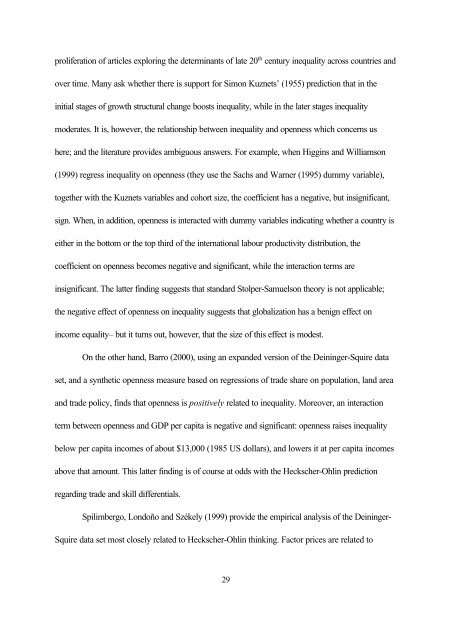Globalization and Inequality - Trinity College Dublin
Globalization and Inequality - Trinity College Dublin
Globalization and Inequality - Trinity College Dublin
You also want an ePaper? Increase the reach of your titles
YUMPU automatically turns print PDFs into web optimized ePapers that Google loves.
proliferation of articles exploring the determinants of late 20 th century inequality across countries <strong>and</strong><br />
over time. Many ask whether there is support for Simon Kuznets’ (1955) prediction that in the<br />
initial stages of growth structural change boosts inequality, while in the later stages inequality<br />
moderates. It is, however, the relationship between inequality <strong>and</strong> openness which concerns us<br />
here; <strong>and</strong> the literature provides ambiguous answers. For example, when Higgins <strong>and</strong> Williamson<br />
(1999) regress inequality on openness (they use the Sachs <strong>and</strong> Warner (1995) dummy variable),<br />
together with the Kuznets variables <strong>and</strong> cohort size, the coefficient has a negative, but insignificant,<br />
sign. When, in addition, openness is interacted with dummy variables indicating whether a country is<br />
either in the bottom or the top third of the international labour productivity distribution, the<br />
coefficient on openness becomes negative <strong>and</strong> significant, while the interaction terms are<br />
insignificant. The latter finding suggests that st<strong>and</strong>ard Stolper-Samuelson theory is not applicable;<br />
the negative effect of openness on inequality suggests that globalization has a benign effect on<br />
income equality– but it turns out, however, that the size of this effect is modest.<br />
On the other h<strong>and</strong>, Barro (2000), using an exp<strong>and</strong>ed version of the Deininger-Squire data<br />
set, <strong>and</strong> a synthetic openness measure based on regressions of trade share on population, l<strong>and</strong> area<br />
<strong>and</strong> trade policy, finds that openness is positively related to inequality. Moreover, an interaction<br />
term between openness <strong>and</strong> GDP per capita is negative <strong>and</strong> significant: openness raises inequality<br />
below per capita incomes of about $13,000 (1985 US dollars), <strong>and</strong> lowers it at per capita incomes<br />
above that amount. This latter finding is of course at odds with the Heckscher-Ohlin prediction<br />
regarding trade <strong>and</strong> skill differentials.<br />
Spilimbergo, Londoño <strong>and</strong> Székely (1999) provide the empirical analysis of the Deininger-<br />
Squire data set most closely related to Heckscher-Ohlin thinking. Factor prices are related to<br />
29
















